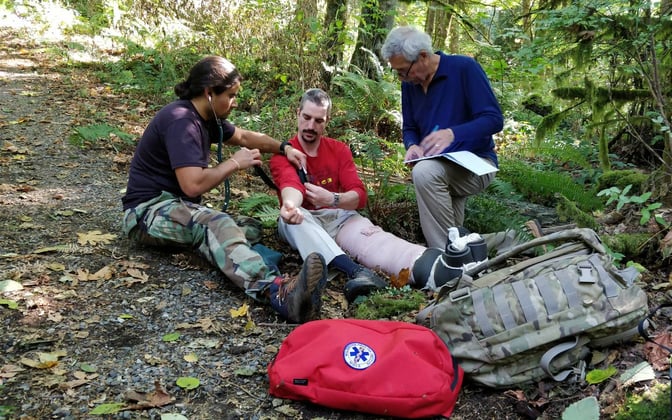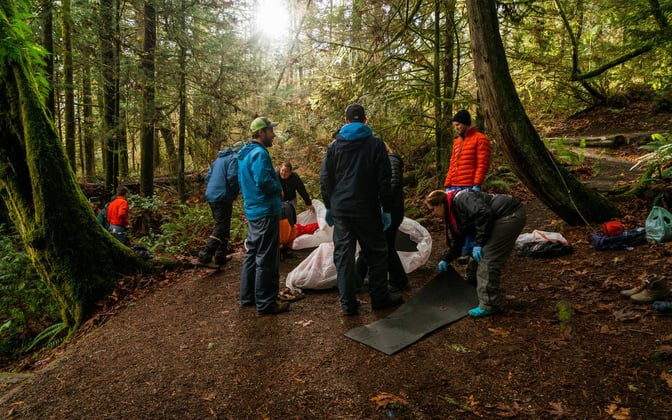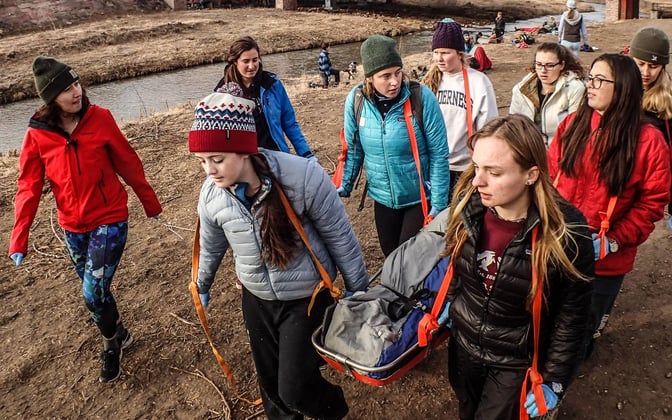So you want to get wilderness medicine training.
The two most common wilderness medicine courses are Wilderness First Aid (WFA) and Wilderness First Responder (WFR). Since you’ll be investing both your time and money in obtaining your certification, it’s helpful to be familiar with each course in order to choose the one that is best for you.
This article will dive into the Wilderness First Aid vs Wilderness First Responder question and, hopefully, steer you in the right direction.
 Photo by Prasad Gadgil
Photo by Prasad Gadgil
What is wilderness medicine?
The phrase “wilderness medicine” may conjure images of rare diseases, unusual injuries, and animal attacks. Perhaps treatments of such maladies involve grinding local flora with a mortar and pestle to great a poultice. There’s romance and intrigue! Indiana Jones might call for a consult!
While all of these things have their place in the world of wilderness medicine, the reality is far less dramatic and far more practical.
Wilderness Medicine vs Urban Medicine
Let’s define “wilderness” medicine in comparison to “urban” medicine. While both labels fall short of capturing their categories, they provide a starting point.
At the broadest level, we can think of urban medicine as what is practiced when we have access to resources like structured pre-hospital care, clinical facilities staffed by people with formal schooling in medicine, and specialists to address specific issues.
At this high level, we can fit wilderness medicine into two categories—as a specialty in urban medicine and as a prehospital approach to patient care. There are many urban health care professionals who have an interest in “wilderness medicine” specialty topics such as envenomation, altitude medicine, and diving injuries and illnesses, and there are several professional societies, fellowships and training programs that support those interests. Perhaps the most widely known is the Wilderness Medical Society (WMS).
Wilderness medicine in the prehospital context has more to do with how responders approach patient care.
In much of the urban world, the Emergency Medical Services (EMS) system can be activated when an accident happens. An ambulance can show up with a team of trained Emergency Medical Technicians (EMTs), a vehicle full of first aid gear, and backup teams as needed. The patient can be cared for and then transported to definite care.
In this context, wilderness medicine indicates a situation in which access to gear is limited, extended care times are likely, additional support resources are minimal or absent, improvised approaches to standard urban procedures may be needed, and access to definitive care may be delayed by hours or days.
Wilderness Medicine at NOLS
NOLS wilderness medicine courses focus on developing the knowledge, skills and confidence to operate in this prehospital wilderness medicine context. Regardless of the course type, the basic approach is the same.
Our Wilderness First Aid (WFA) and Wilderness First Responder (WFR) courses are classroom-based programs where we strive for a 50/50 balance of lectures and hands-on practice. In each course, you’ll learn about a range of issues that you might deal with in remote settings, including environmental challenges like heat illness, altitude illness, hypothermia, medical issues like cardiac or respiratory emergencies, and trauma like head or musculoskeletal injuries.
Courses generally go from 8am to 5pm, and longer courses (like our WFR certification course) may include an evening session or two. Students range in age from 16 to 90, and they come from all walks of life. Let’s look at our two most popular courses a bit more closely.
Wilderness First Aid Certification
Who is WFA for?
Wilderness First Aid courses are designed for casual recreationalists who generally take short trips relatively close to medical resources, work at wilderness camps, or enjoy weekend family outdoor activities.
Generally speaking, people holding WFA certification do not have to provide medical care as a major part of their job.
This course is great for people of all experience levels who want introductory-level training to make them feel more prepared to handle basic backcountry medical emergencies.
 Photo by William Woodward
Photo by William Woodward
What will you learn during a WFA course?
At the start of the 16-hour Wilderness First Aid certification course, students will learn the foundation of all first aid—the patient assessment system. The rest of the course is spent applying that assessment system to a wide range of common situations that might arise in the outdoor setting.
The progression begins by exploring traumatic injuries and how to handle them. Topics include head and chest injuries, managing potential spine and spinal cord trauma, and the bread-and-butter of backcountry issues—musculoskeletal injuries. WFA students will learn how to assess these injuries, how to best support their patients, and, most importantly, how to make sound evacuation decisions.
After the trauma topics, the WFA course shifts its focus to environmental challenges. Students will learn how to handle complications presented by altitude, hypothermia and cold injuries, and issues associated with heat management and hydration. Prevention is a major theme, and students will learn the basic tenet of how to head these problems off before they even begin.
Following the environmental topics, students will shift into the realm of medical emergencies. Events like respiratory emergencies, cardiac events and allergic reactions will be addressed. Again, the training will focus on prevention, treatment and appropriate evacuation decisions. The patient assessment system remains the constant underpinning of the training, and by the end of the course students will feel empowered to act confidently to support their friends and family when things go awry in remote areas.
Some WFA courses have an additional 4-hour session to provide CPR certification. Depending on the course, this CPR session may be conducted the evening before or the morning after the 16-hour WFA course itself. Explore our Wilderness First Aid with CPR course for more details.
Wilderness First Responder Certification
Who is WFR for?
A Wilderness First Responder (WFR) course is for you if you work or recreate in an outdoor setting or in other austere environments where access to medical care is delayed or communication is unreliable. Whether you're a seasoned wilderness enthusiast, a dedicated outdoor educator, or an aspiring wilderness guide, a WFR course is designed to empower you with the experience and practical skills required to stay calm and responsive in disaster relief and medical emergency scenarios.
NOLS' Wilderness First Responder courses are the industry standard for professional wilderness guides, trip leaders, search and rescue team members, outdoor professionals, and international travelers. The goal of the WFR course is to prepare graduates to provide patient care in remote locations for extended periods of time, often with limited resources and communication tools. WFR graduates often need to make independent decisions about patient care, urgency of evacuation, and the need for additional rescue resources.
 Photo by eric page
Photo by eric page
What will you learn during a WFR course?
WFR courses are offered in two formats: traditional 9 or 10-day in-person courses and 5-day hybrid courses. Traditional courses may include a day off (hence the 9 or 10-day variations) and generally include two evening sessions. Hybrid courses begin with several online modules completed at your own pace that are then followed by 5 in-person days. There are usually two evening sessions during the hybrid course in-person days, as well. CPR is a standard component of WFR training.
WFR courses cover a much broader range of topics at greater depth compared to WFA courses. Students add more tools to their Patient Assessment System and then dive into the challenge of applying that system to a variety of patients.
Instructors spend time discussing anatomy, physiology, and pathophysiology to better equip WFR certification holders to make challenging decisions in the field. Students will have the opportunity to participate in several extended care scenarios in which they will make ongoing care decisions while figuring out how to get their patients to definitive care.
Students will explore the intricacies of decision-making models that will improve their critical thinking skills. They will become familiar with the NOLS leadership model and get the chance to step into leadership roles in the emergency medicine environment. Prevention of medical emergencies is an ongoing theme in any wilderness medicine course, and WFR students will graduate with a good understanding of their role in keeping their traveling companions safe in remote environments.
NOLS Wilderness First Responder courses are approved as continuing education units for EMTs, and these courses can also be used to earn physician-level continuing education credits, as well. WFR courses also provide credit toward Fellowship in the Academy of Wilderness Medicine (FAWM), overseen by the Wilderness Medical Society.
Wilderness Medical Training for Other Medical Professionals
In addition to the WFA and WFR programs designed for wilderness enthusiasts and outdoor professionals, we also offer training designed for medical professionals looking for ways to expand their skill set.
If you have been trained as an EMT or higher (paramedic, RN, NP, PA, MD, etc), consider taking either our 2-day Wilderness Medicine for the Professional Practitioner (WMPP) course, our 5-day Wilderness Upgrade for Medical Professionals (WUMP) course, or our 9-day Wilderness Medicine Expedition.
These programs build on your existing familiarity with patient care by challenging you to apply your skills with limited access to resources and with extended patient contact times. These courses are also approved for continuing medical education units.
What's The Bottom Line? It’s Up To You!
If you're still asking, "Should I get a WFA or WFR certification?,", consider this:
The choice between WFA and WFR depends on your needs and the environments you frequent.
If you often engage in short, day-long outdoor activities or are just starting to get involved in outdoor recreation, a WFA course may be sufficient. It provides basic skills to manage common outdoor injuries and illnesses.
However, if you lead extended backcountry trips, work in remote environments, or want a more comprehensive skill set, the WFR course is the better choice, offering an in-depth understanding and broader range of emergency response skills.
That said, it’s hard to make a bad decision regarding wilderness medicine training, but if you still have questions about the differences in wilderness medicine courses, please reach out to our team of Admissions Officers. They’re happy to help you make the best choice!
Written By
Gates Richards
Gates Richards has been involved in outdoor education and EMS since the early '90s. Over the years he's worked outdoor programming throughout the Rockies, Pacific Northwest and Alaska. He's worked urban EMS in DC, WA, CO and WY. Gates began teaching for NOLS Wilderness Medicine in 1998 and has been awarded the Wilderness Medical Society's Warren Bowman award for contributions to wilderness medicine by a non-physician as well as the National Collegiate EMS Foundation's Distinguished Service Award. He was the former Associate Director and is currently a NOLS Wilderness Medicine Faculty member.



